Introduction
Giraffes are large and sociable African, hooved mammals, famous for their elegant long necks and patterned skins. Africa is home to four species of giraffe: Masai, Southern, Northern and Reticulated giraffe, with several subspecies who live in geographically distinct areas throughout the continent. The numbers of giraffes have plummeted desperately low to a total of approx. 97,562 in the wild.1https://www.iucnredlist.org/species/9194/136266699#population
Uganda is home to over half of Africa’s Nubian (formerly Rothschild’s) giraffes (G. c. camelopardalis), a subspecies of the Northern giraffe.2https://giraffeconservation.org/wp-content/uploads/2019/04/Ugandas-Giraffe-LR-c-GCF.pdf
According to the IUCN Red List of Threatened Species, there are only around 1,333 giraffes in Uganda3https://www.iucnredlist.org/species/174469/51140829#population, but recent figures from the Uganda Wildlife Authority (UWA) estimate a number closer to 2,420.4https://giraffeconservation.org/wp-content/uploads/2023/09/State-of-Giraffe-2023-Uganda-spreads.pdf Most of Uganda’s giraffes are found in Murchison Falls National Park (2,250), but small numbers have been reintroduced into Lake Mburo National Park (52), Kidepo Valley National Park (77) and Pian-Upe Wildlife Reserve (35).
Thanks to concerted efforts by the UWA the giraffe population in Uganda has been slowly increasing but these numbers are still worryingly low, and the giraffe is still in decline and critically endangered across the rest of Africa. Giraffes live to 25 years old in the wild.
Fascinating facts
Head in the clouds

Giraffes are the world’s tallest living animals. An adult male can grow to over 19 feet tall (5.5 metres), females tend to be slightly smaller, and even a newborn calf is 6 feet (1.8 m). Their height allows them to see predators far in the distance and reach their favourite luscious leaves, fruits and flowers in the treetops.
A confusing discovery
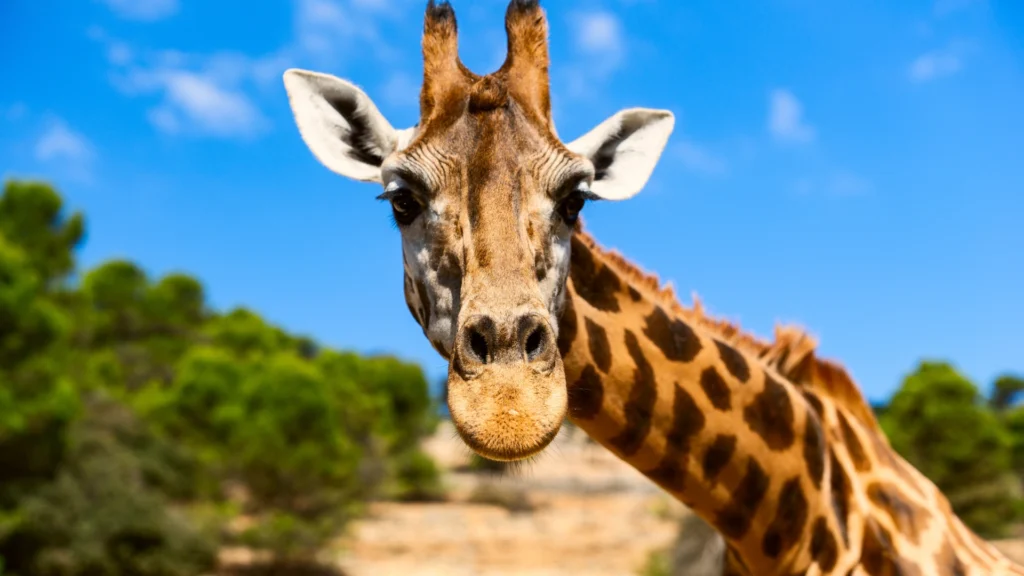
When explorers first stumbled upon giraffes they didn’t know what to make of them. They described them as a cross between a camel and a leopard.5https://ugandawildlife.org/animals/giraffe/
The cherry on top
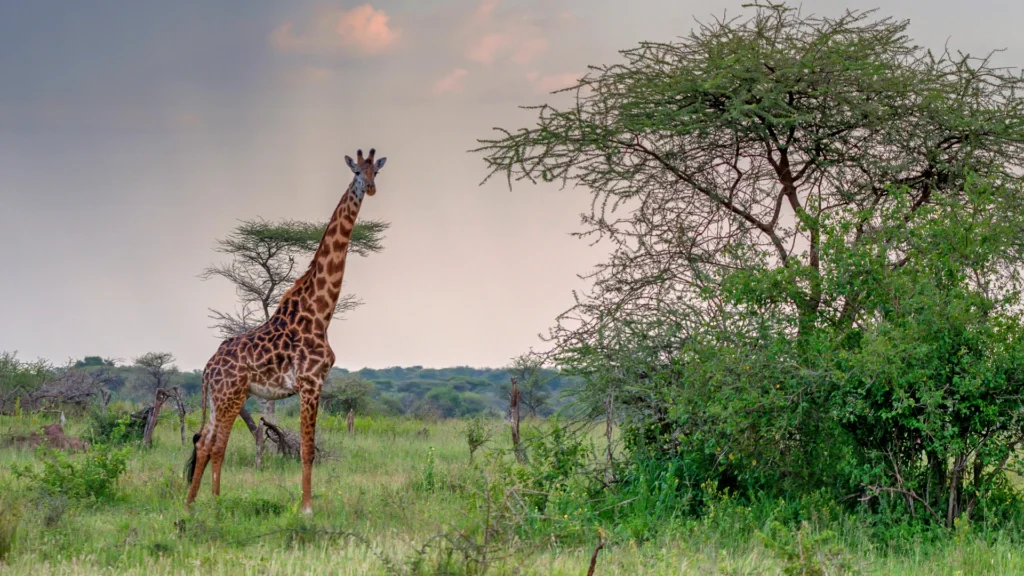
Giraffes are herbivores and can munch their way through seven stone (45 kg) of leaves every day! They can weight up to a tonne so need a lot of leaves to maintain good health. Their favourite food is the freshest leaves and buds at the top of the acacia tree. They use their long necks and equally impressive tongue, which can grow to 53 centimetres long, to reach and pull down this tasty treat.6https://www.natgeokids.com/uk/discover/animals/general-animals/ten-giraffe-facts/
Not heavy drinkers
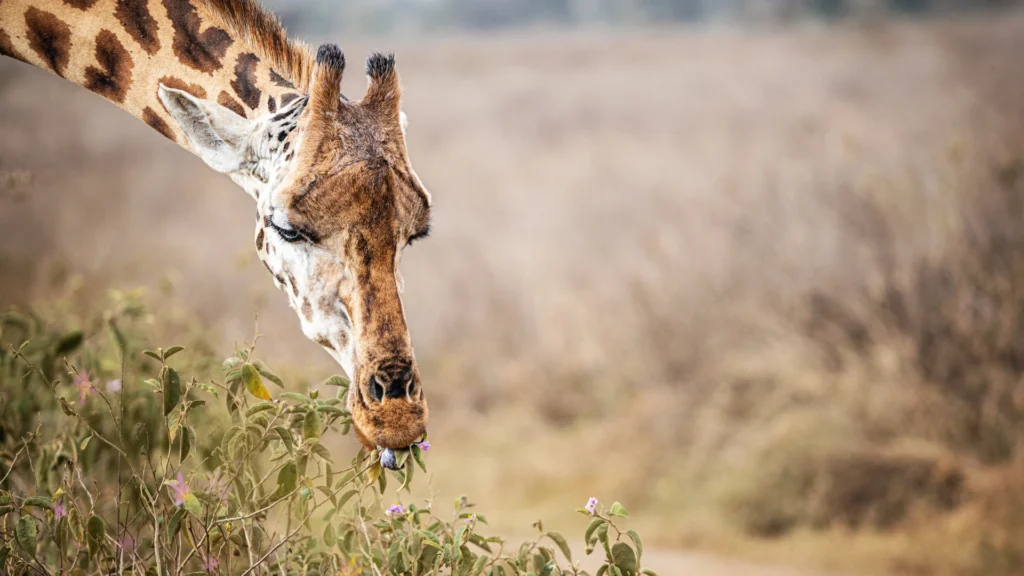
Although giraffes eat a lot, they don’t drink much water. This is because they get most of their water from the luscious leaves they eat. They only need to drink once every few days.7https://academic.oup.com/book/41222/chapter-abstract/350699181?redirectedFrom=fulltext Despite having very long necks, they aren’t long enough to reach the ground without the giraffe having to splay their front legs or bend their knees,.
A group of giraffes is called a tower
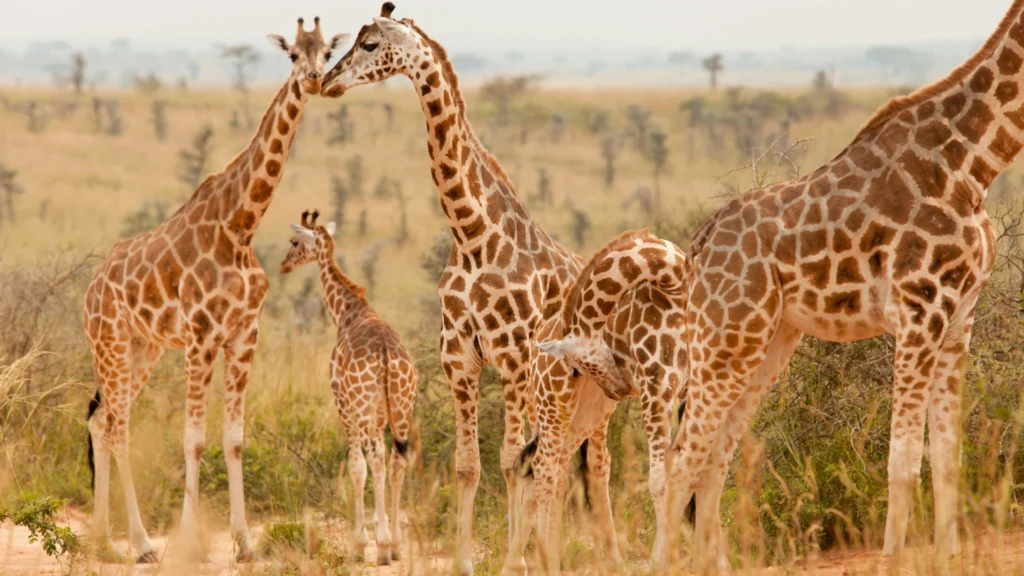
Giraffes live in herds – or towers – of around 15 individuals. The tower is led by a dominant male (called a bull) and the other members are adult females (called cows) and young males and females. Male calves leave their mothers from about 15 months and usually join bachelor herds. The female young, however, often stay in the same herd as their mothers. If they leave, they do so at about 18 months and frequently live in the same vicinity as their family.
Necking

When males fight to see who is the strongest, they repeatedly swing their long neck to deliver powerful head-butts to their rival’s body and underbelly. A reinforced skull usually absorbs the impact of these blows, though they might end up with a headache or sore neck! Occasionally a giraffe is knocked unconscious and very rarely even dies during such a fight.
A big heart
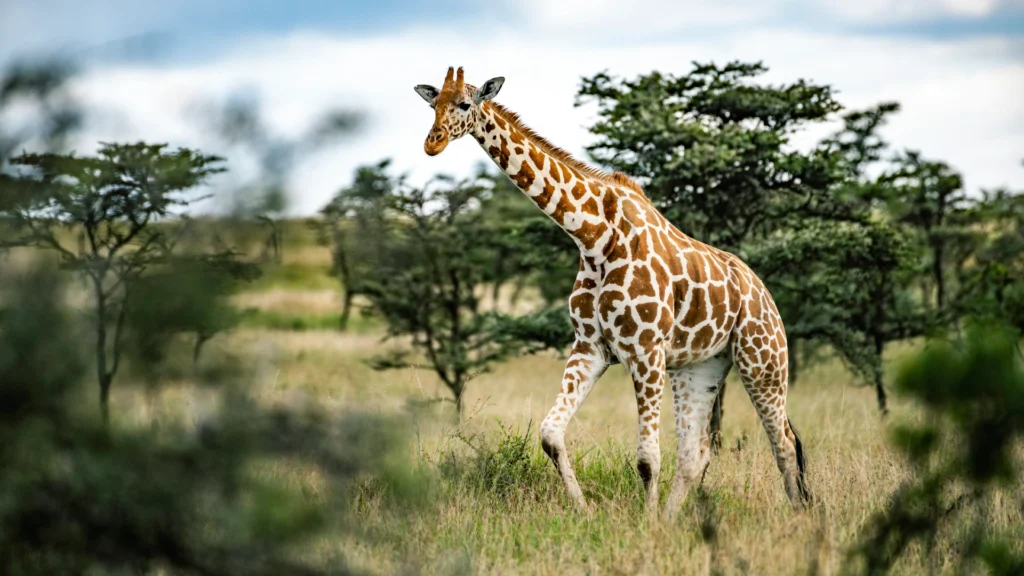
A giraffe’s heart can weigh up to 1.7 stone (11 kg). The heart has to produce almost double the normal blood pressure of other mammals to keep blood flowing to the brain against gravity.8https://giraffeconservation.org/facts/why-do-giraffe-have-such-a-long-neck/
Cool spots

All giraffes have different spotty patterns, like our fingerprints, in that they are unique to every individual. The patches are important for camouflage. But they have another cool function. Underneath each one lies a sophisticated network of blood vessels that helps to reduce body heat on sweltering days.9https://www.clevelandzoosociety.org/z/2023/07/06/truth-or-tail-giraffe-spots-are-like-fingerprint
Falling to Earth
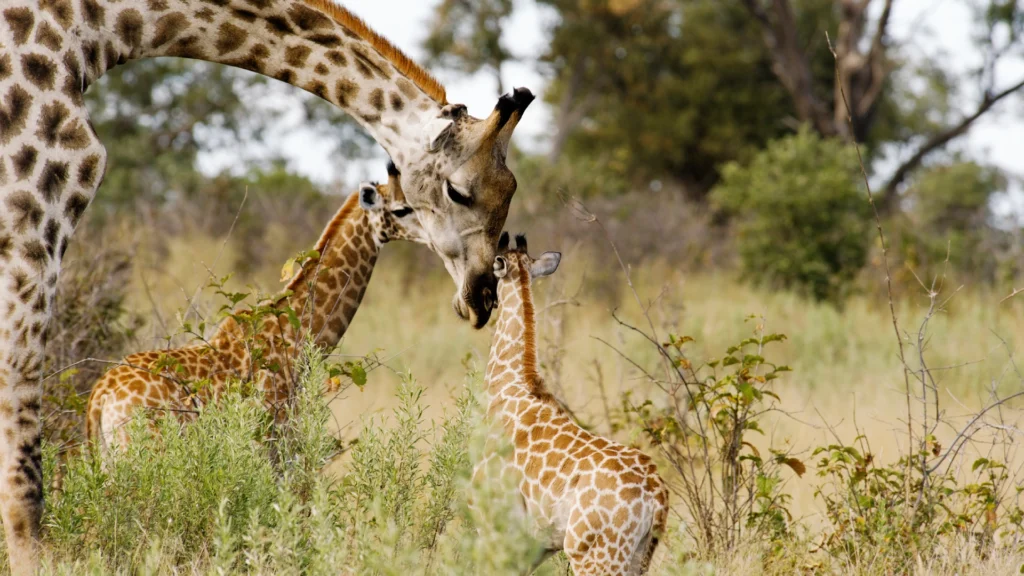
A female giraffe is pregnant for 15 months before giving birth to one calf. The mother gives birth standing up so the calf has a 1.5 metre fall to the earth when they are born. But giraffe calves are tough, and within one hour they will be standing up, suckling and walking. The calf needs to be tall at birth to be able to reach their mother’s teats.
A love like no other
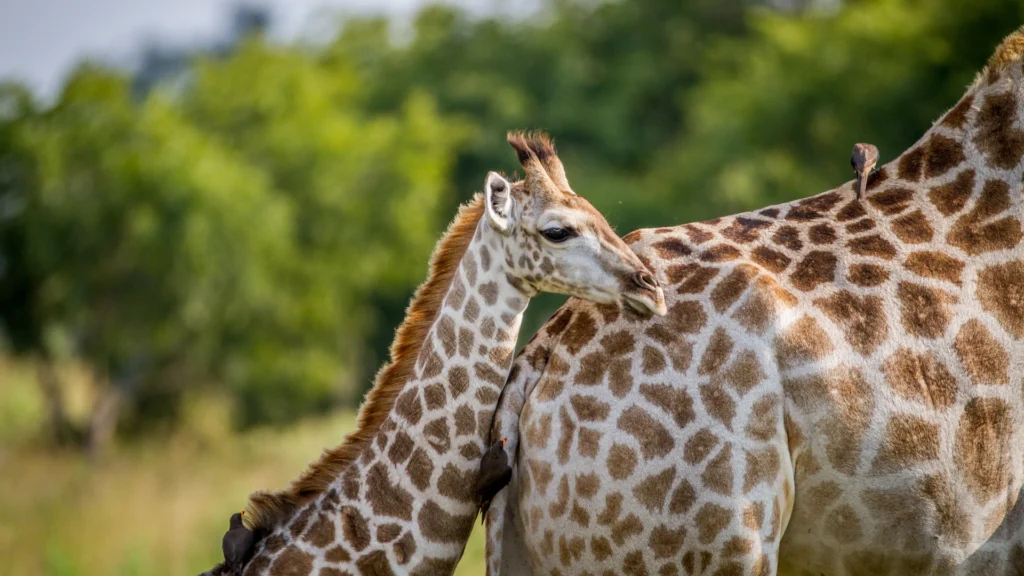
A mother giraffe is extremely protective of her calf. She will suckle them for up to a year, even though the calf will start eating leaves when they are four months old. If the calf is threatened by a predator, the mother can deliver a powerful kick to boot away anyone who comes too close.
Giraffe perils
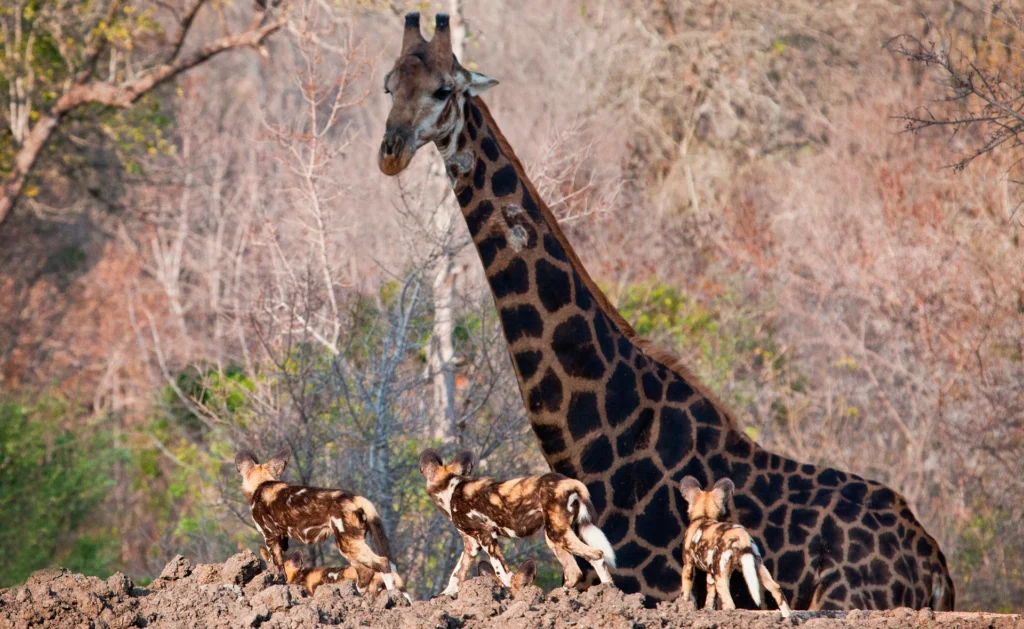
Adult giraffes have few predators due to their enormous size and lions have been known to be killed by their almighty kick. However, the young are vulnerable and predators include lions, leopards, hyenas, African wild dogs and crocodiles. Over half of giraffe calves are killed in their first year in some populations.
While their mothers feed, newborn giraffes will be left sitting in long grass. After a few weeks the baby will be introduced to the herd. Sometimes giraffes form nursery groups, where one mum will watch for danger, while the others forage.
Threats to giraffes
Poaching
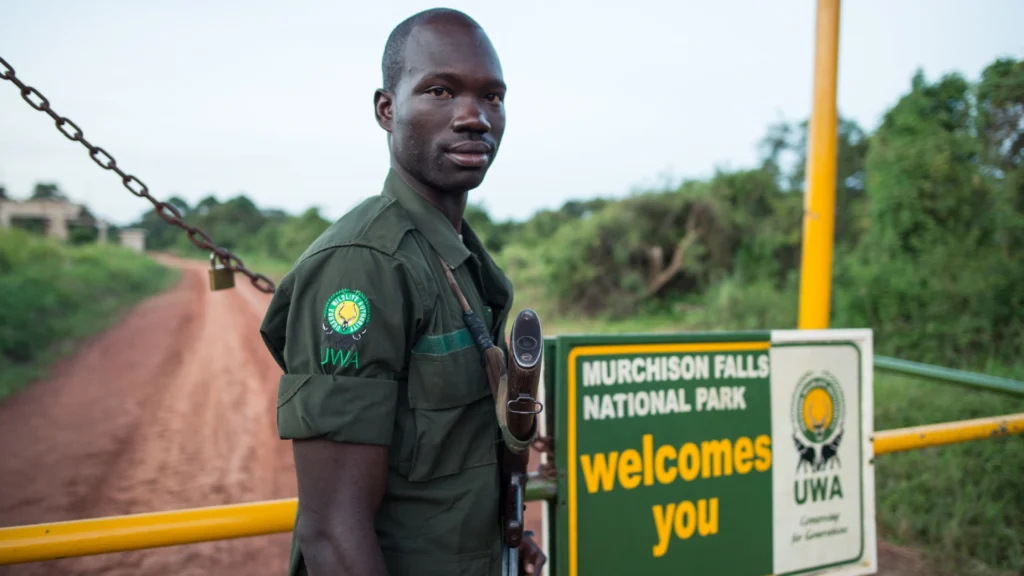
Poaching has wiped out most of Uganda’s giraffes. As soon as they were discovered, their unique appearance made them a prime target for hunters. Their skins are prized for their decorative patterns and their tails and hair are used to make bracelets, fly-swatters and threads for sewing. Giraffes are also often snared for bushmeat across many parts of Africa.10https://www.biologicaldiversity.org/species/mammals/giraffe/index.html Illegal hunting caused giraffes to disappear from Lake Mburo National Park about 100 years ago; Kidepo Valley National Park had only three remaining giraffes in the 1990s.5https://ugandawildlife.org/animals/giraffe/ Pian-Upe Wildlife Reserve once had the highest number of Nubian giraffes but civil unrest and poaching completely decimated the giraffes until there were none left.11https://giraffeconservation.org/2020/12/17/operation-twiga-v/
In the wake of the Covid-19 pandemic, the poaching of wildlife in Uganda intensified. Many would-be poachers made a living from tourism but when the world shut down in 2020, tourism came to an abrupt halt and many Ugandans were left with no income. So, to find food, these local people took to hunting. Endangered animals like lions, gorillas and giraffes were not their target – smaller animals like warthog and antelopes were – but snares are indiscriminate killers and many giraffes suffered slow and agonising deaths from their wounds. In just one day in June 2020, rangers found seven dead giraffes, snares cutting into their legs, in an area once popular with tourists.12https://www.nationalgeographic.co.uk/animals/2020/07/pandemic-induced-poaching-surges-in-uganda
Without the dedication of the park rangers, who patrol Uganda’s national parks day and night, removing snares and putting their lives on the line to protect the wildlife, there is no doubt that the giraffes would be hunted to extinction.
Habitat loss

As a result of Uganda’s population growth, increased urbanisation, and an increased income for wealthier Ugandans, the demand for animal products is likely to dramatically rise in the coming years. The FAO estimates that by 2050, the demand for meat and milk products in Uganda will more than double and “the production of all types of meat and that of milk will increase by 164 and 41 per cent, respectively.”13https://www.fao.org/3/ca7009en/CA7009EN.pdf
To produce these animal products, land that was once beautiful and iconic savannah and forest – and a home to Uganda’s majestic wildlife – is being turned into farmland. The conversion of land to agriculture is stripping the wildlife of its natural habitat and putting increasing pressure upon the land to support life. In the last one hundred years, Uganda has lost 42 per cent of its forest cover, decreasing from 54 per cent to 12 per cent in 2017.14https://illuminem.com/illuminemvoices/deforestation-in-uganda-causes-and-recommendations Encroachment into Queen Elizabeth National Park by illegal cattle ranchers is common15https://conbio.onlinelibrary.wiley.com/doi/abs/10.1111/cobi.12538?campaign=woletoc and the National State of the Environment Report for Uganda 2014, attributes this to “the increasing demand of land for agriculture and fuel wood by the rapidly increasing population growth.”16https://nema.go.ug/sites/all/themes/nema/docs/FINAL%20NSOER%202014.pdf
Of course, a growing population needs food but it would be much more sustainable to meet these needs through the growing of crops instead of farming animals. Animal foods require by far the most land and resources – this is because land is not only used for grazing but also for growing food for the animals. The more animal-based foods we eat, the more endangered our forests become. However, crops are a far more efficient way to feed the growing population and use less land and other natural resources. A vegan diet is associated with only half the cropland demand, grazing intensity and overall biomass harvest of meat-based diets17https://www.nature.com/articles/ncomms11382 so switching to a vegan diet would have a phenomenal impact on reducing deforestation and land degradation in Uganda.
To make matters worse, huge amounts of oil have been found under Murchison Falls, Uganda’s largest national park, and despite worldwide opposition by conservationists, French oil company TotalEnergies began drilling in the park in 2023.18https://www.afrik21.africa/en/uganda-totalenergies-begins-drilling-for-oil-in-the-murchison-falls-national-park/ Not only will all the industrial activity disturb and startle the giraffes, but roads created will also make it easier for poachers to access the park. In an attempt to save the giraffes, 20 of them have been relocated to a southern area of the park, where a river separates them from the oil operation.19https://www.nrdc.org/stories/save-these-rare-giraffes-uganda-built-ark-sorts
Fifty years ago, Uganda’s giraffes could freely roam across the country but today they have become isolated in parks and reserves, cut off from each other by human developments. It is becoming harder and harder for giraffes to find enough food to sustain their large appetites in a restricted and diminishing environment.
References
References
- 1
- 2
- 3
- 4
- 5
- 6
- 7
- 8
- 9
- 10
- 11
- 12
- 13
- 14
- 15
- 16
- 17
- 18
- 19

